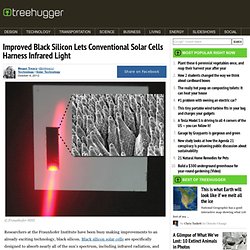

‘Absolute Black’ Solar Panels Absorb Almost All Sunlight. Mar 29, 2012 7:00am A clean-room technician holds a black silicon solar-power wafer.

Natcore Technology, Inc. Solar power is one of those technologies that have been promised to be just a few years from profitability for 30 years. Solar panels are an environmentalist’s dream — limitless electricity from the sun with no air pollution or carbon dioxide emissions — but they’ve had a hard time competing with coal, natural gas, oil and other sources of energy. Can that change? “One of the ways this matters,” said Chuck Provini, the company’s CEO, “is that there isn’t a whole lot of difference between the electricity you get on a sunny day vs. a cloudy day. The new panels, Provini said, will not require hazardous chemicals to produce and should help drive down the price of solar energy. “Black silicon will improve power output and reduce cost — the two things that matter most,” he said.
Improved Black Silicon Lets Conventional Solar Cells Harness Infrared Light. © Fraunhofer HHI Researchers at the Fraunhofer Institute have been busy making improvements to an already exciting technology, black silicon.

Black silicon solar cells are specifically designed to absorb nearly all of the sun's spectrum, including infrared radiation, and convert it into electricity. Conventional solar cells, on the other hand, are able to convert the three-quarters of the spectrum not including infrared into electricity. If these two technologies could work together, conventional solar cells could be far more efficient. The Fraunhofer researchers believe that we're close to seeing that happen. Black Solar Cell Absorbs 99.7% of All Light. © Natcore Technology Scientists over at Natcore Tech have created what is now the "blackest" solar cell to date.

While that might sound as trivial as creating a white iPhone, this is a fairly huge advancement in the world of solar technology. With an average reflectance of 0.3%, these black silicon wafers absorb more light than any other out there, which means more of the sun's energy is actually converted into energy. By the way, reflectance is the ratio of reflected light to that of which actually hits the surface. So a reflectance of 0.3% means that only 0.3% of all light is reflected from the solar cell's surface and that the remaining 99.7% is absorbed. This breakthrough makes industry standards such as anti-reflective coatings now obsolete. “One of the ways this matters,” said Chuck Provini, the company’s CEO, “is that there isn’t a whole lot of difference between the electricity you get on a sunny day vs. a cloudy day.
Solar cells made from black silicon - Research News October 2012 - Topic 2. The Sun blazes down from a deep blue sky – and rooftop solar cells convert this solar energy into electricity.
Not all of it, however: Around a quarter of the Sun’s spectrum is made up of infrared radiation which cannot be converted by standard solar cells – so this heat radiation is lost. One way to overcome this is to use black silicon, a material that absorbs nearly all of the sunlight that hits it, including infrared radiation, and converts it into electricity. But how is this material produced? “Black silicon is produced by irradiating standard silicon with femtosecond laser pulses under a sulfur containing atmosphere,” explains Dr. Stefan Kontermann, who heads the Research group “Nanomaterials for Energy Conversion“ within the Fraunhofer Project Group for Fiber Optical Sensor Systems at the Fraunhofer Institute for Telecommunications, Heinrich-Hertz-Institut, HHI. Prize-winning project. Black silicon could boost efficiency of traditional solar cells.
Researchers at the Fraunhofer Institute for Telecommunications have developed a system that allows solar cells to effectively harvest energy from the infrared spectrum, tapping into a source of energy that in the past has mostly been out of reach.
The new technology, which promises to work well with commercially available solar cells, has the potential of becoming a standard in the solar panels of tomorrow. When photons hit the surface of a solar cell, the energy they carry can be absorbed by a semiconductor. If the energy absorbed is higher than a set threshold – which is known as the energy gap, and depends on the semiconductor used – electrons are freed from the semiconductor and can be used to generate an electric current. The energy carried by a photon is proportional to its frequency. In silicon solar cells, photons in the infrared often don't carry enough energy to produce electricity, and IR light simply passes through the cell, unused.
Source: Fraunhofer HHI. Fraunhofer black silicon could catch more energy from infrared light, go green with sulfur. Solar cells made from black silicon. Solar Efficiency of Black Silicon Doubled (photonics.com. BERLIN, Oct. 2, 2012 — A solar material that takes advantage of a spectrum totally unused by standard cells could be the key to more efficient photovoltaics, now that a team in Germany has successfully doubled its efficiency. Solar cells convert three-quarters of the energy in the sun’s spectrum into electricity, but about a quarter of its spectrum — the infrared — is lost in standard solar cells. Black silicon cells, however, are specifically designed to absorb nearly all of the sunlight that hits them, including IR radiation. “Black silicon is produced by irradiating standard silicon with femtosecond laser pulses under a sulfur-containing atmosphere,” said Dr.
Stefan Kontermann, head of the Nanomaterials for Energy Conversion department within Fiber Optical Sensor Systems at Fraunhofer Institute for Telecommunications, Heinrich Hertz Institute (HHI). Black Silicon Solar - Home.